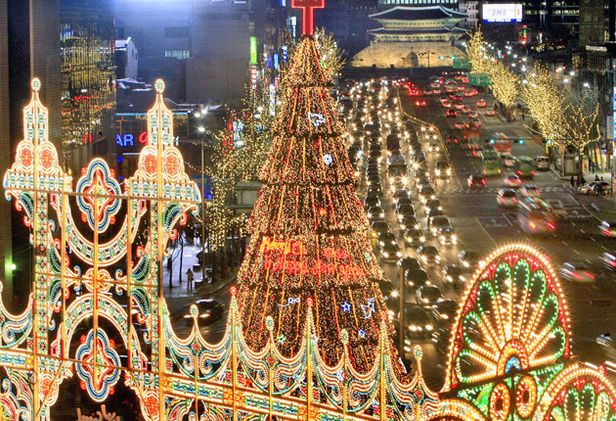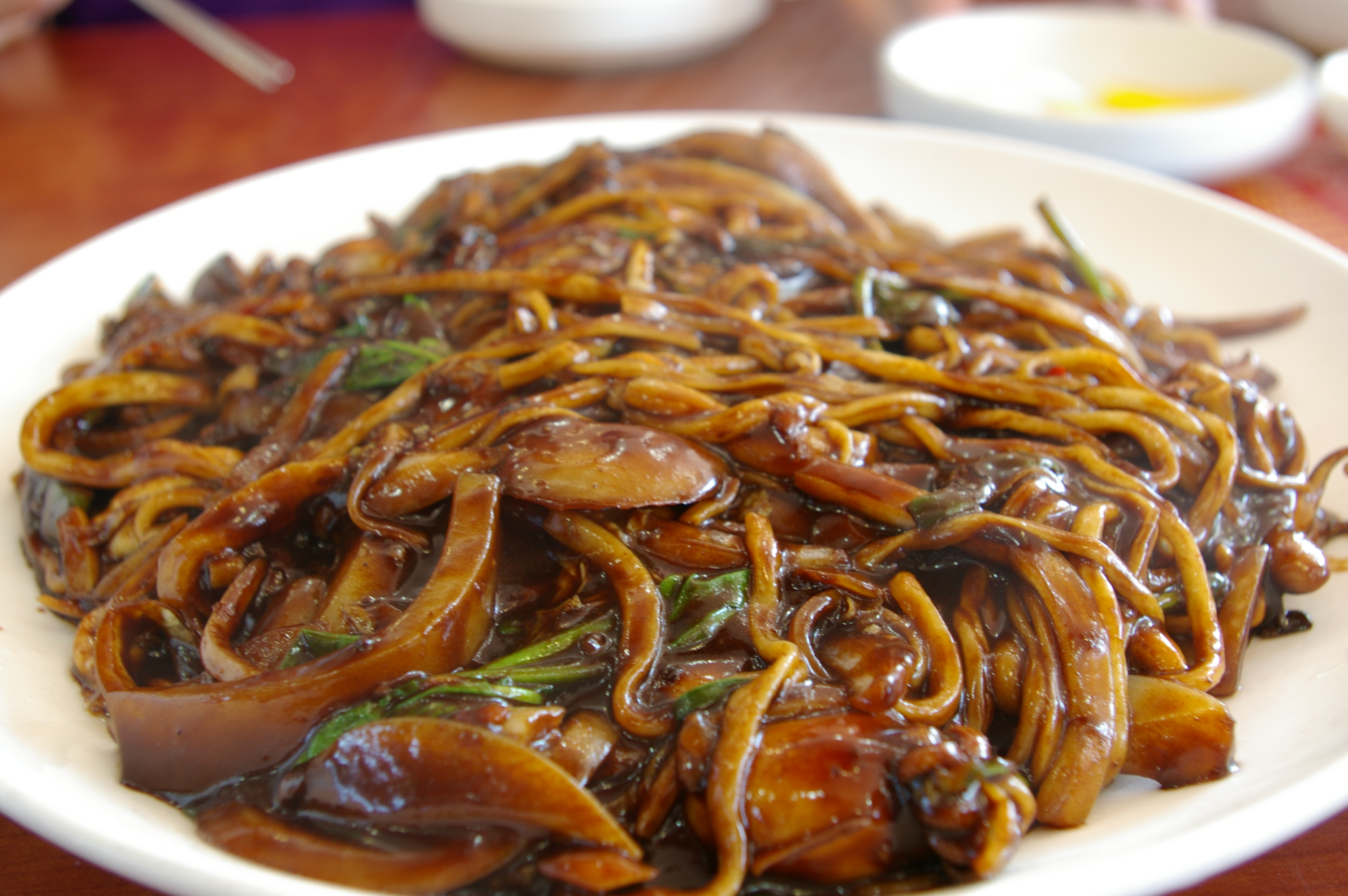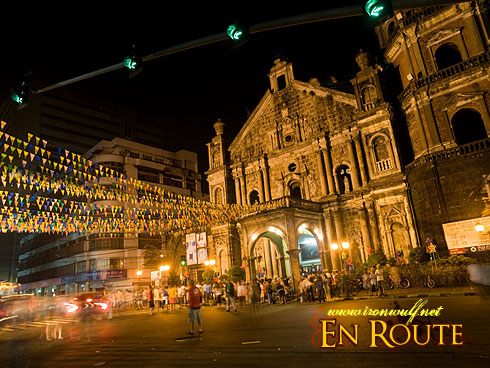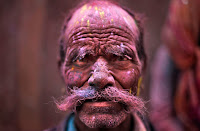Hi everyone! Our group has put together this video to demonstrate Cultural Celebrations in our society, enjoy!
Tuesday, 28 May 2013
Sunday, 5 May 2013
A Korean Christmas
Christmas falls on the 25th of December in Korea; just like everywhere else. Christianity is quite young in Korea compared to other nations, with only 2% of the population identifying with the religion in 1945 after almost 200 years of contact from western missionaries. However, following the end of World War II in 1945 and Korea's independence from Japanese occupation, Christianity saw a rapid growth in Korea with the total percentage of Christians in South Korea today being 29.2%. Therefore, it is no surprise that Christmas is celebrated as a religious event, as well as a social one (the majority of the population is non-religious).
Christmas sees many services held across churches in Korea in the days leading up to the 25th; Protestant and Catholic alike. For the Christian family, Christmas is a time to come together to celebrate Christ's birth as well as wishing good cheer and blessings. However, unlike western traditions, Christmas doesn't hold as strong an emphasis on the family coming together. Rather, Christmas, like Halloween, has been adopted as a key day on the calendar for couples and love; which isn't so surprising considering the nation's obsession with romance.
Christmas in big cities such as Seoul and Busan will see immense displays of decorative lights. Every shop, cafe, and building will be lined with festive decorations and of course, have an endless stream of Christmas songs. Even the many bridges that link the banks of the Han river in Seoul are decked with festive lights. It is customary for the exchanging of gifts to occur, and to celebrate with a 'Christmas cake' which would be purchased from your local bakery or cafe.
In short, Christmas is a most festive occasion in Korea for the young and old; the religious and non-religious. It is celebrated with food, company, and a break from the long work hours of South Korea.
-David
Sources:
http://seoulbeats.com/wp-content/uploads/2012/12/20121212_seoulbeats_xmas3.jpg
http://farm9.staticflickr.com/8352/8303951912_778049287c_z.jpg
https://blogger.googleusercontent.com/img/b/R29vZ2xl/AVvXsEjiULgLw1kuBrizRBwekUvNE7mHcWjmIHsEystmNDU540AH4wxx9WDGcWdU22F6QPio3EhGK5AyVh86E1iWCTBMHlOW-kQo8IYc6c7icEIGF8RSAa25O-STtpTLtslM-xcBZwqqRY_y4mY/s320/IMG_3051-.jpg
Sources:
http://seoulbeats.com/wp-content/uploads/2012/12/20121212_seoulbeats_xmas3.jpg
http://farm9.staticflickr.com/8352/8303951912_778049287c_z.jpg
https://blogger.googleusercontent.com/img/b/R29vZ2xl/AVvXsEjiULgLw1kuBrizRBwekUvNE7mHcWjmIHsEystmNDU540AH4wxx9WDGcWdU22F6QPio3EhGK5AyVh86E1iWCTBMHlOW-kQo8IYc6c7icEIGF8RSAa25O-STtpTLtslM-xcBZwqqRY_y4mY/s320/IMG_3051-.jpg
Friday, 3 May 2013
Rakhi (the bond of protection)
Rakhi, or Raksha Bandhan, is a tradition and festival in India carried out by Hindus to celebrate the special relationships between siblings and cousins.
The mythology of Rahki comes from the notion that Ganesh had two sons, Shubh and Labh. On Raksha Bandhan, Ganesh's sister visited and tied a rakhi on his wrist. Thus, as tradition, the Hindu tradition marks this celebration annually coinciding with the full moon "Purnima"
The Rakhi is a sacred thread that represents brotherhood and is tied around the wrists by the sister to symbolise love and hope for the brother's wellbeing. The rakhi can also be tied for those who we may consider our brothers but have no genetic relation to, providing that the commitment is made for life along as they obtain the obligation to provide protection to the "sister".
The brothers present their sisters with an envelope containing money or presents such as saris.
 Sweets are also a customary tradition of Rahki. Usually is fed to each other between siblings.
Sweets are also a customary tradition of Rahki. Usually is fed to each other between siblings.

The holy rahki thread comes in a variety of colours and styles
Rahki can be tied for siblings of all ages as seen in the pictures. The colours are bright and vibrant.

 - Madhu
- Madhu
REFERENCES
For Pictures (In Order):
Pahiyas Festival
 Pahiyas Festival is a bright and
beautiful feast which occurs on the 15th of May by locals of Lucban,
Quezon, commemorating the San Isidro Labrador, as well as farmers’ thanks for a
bountiful harvest. The celebration itself has been celebrated all the way back
to the 16th century, and legend was that San Isidro Labrador would
magically plow the farmer’s crop whenever he left the local church. There is a
vibrant array of colors displayed in the festival using various fruits,
vegetables, and hand-crafted items in every house in town.
Pahiyas Festival is a bright and
beautiful feast which occurs on the 15th of May by locals of Lucban,
Quezon, commemorating the San Isidro Labrador, as well as farmers’ thanks for a
bountiful harvest. The celebration itself has been celebrated all the way back
to the 16th century, and legend was that San Isidro Labrador would
magically plow the farmer’s crop whenever he left the local church. There is a
vibrant array of colors displayed in the festival using various fruits,
vegetables, and hand-crafted items in every house in town.
In the parade itself, there are a
lot of customs:
- A procession, with big papier mâché statues of a farmer and his wife, followed by a patron saint, with a basket that holds biscuits to be given to children
- Streets and homes are decorated with the seasons harvest, including fruits, vegetables, rice grains/stalks, flowers, ferns and rice wafers
- A competition to see whose home is the most creatively decorated, of which the decorations of the house will be taken down to be fed to festival-goers for free
·
Displaying of harvest so that the local parish
priest may “bless” the food as the procession passes by
-Patrick
Sources of Images:
Thursday, 2 May 2013
The Four 'Romantic Holidays'
In the calendar year, there are four 'romantic' days for Koreans in the modern age. These days do not have long cultural histories for most of them were established during the 20th century.
The first of the four is Valentine's Day which is just like the ones held around the world on the 14th of February except with a tweaked focus of the girls presenting their romantic interest or significant other with chocolate and gifts. However, it is not a rule set in stone and some couples and individuals choose to celebrate the day in the more common way.
The second of the four is White Day on the 14th of March. It is the reverse of Valentine's Day in that it is the guys' turn to either return the 'proposed' affection on Valentine's with chocolate and gifts on White Day. For people in relationships, it would just be a 'second half' to the 2-part series.
The third of the four is Black Day which is held on the 14th of April. It is a Singles Awareness Day of sorts in Korea, as it is a day for singles who did not receive gifts on either Valentine's or White Day. The tradition is that singles would meet or go out to eat jjajangmyeon (짜장면), white Korean noodles with black bean sauce, to either celebrate or hold back the sorrows of singledom.
The fourth and last is Pepero Day held on the 11th of November (11/11). It is named after the snack cookie sticks and falls on the particular day as 11/11 resembles four Pepero sticks in a row. It is like Valentine's and White Day in that confectionary and gifts are exchanged and gifted; but with the factor of no limitations of whose 'turn' it is.
These four holidays are very commercial in nature, and are observed mainly by the younger population of Korea; which is the majority of the population considering the high majority of the population are under the age of 50.
-David
Sources:
http://1.bp.blogspot.com/-V6JcuZt_GP0/TViN55yE2aI/AAAAAAAACdk/7NjbekLWdiY/s320/heart.jpg
http://www.todayandtomorrow.net/wp-content/uploads/2008/03/louis_vuitton.jpg
http://upload.wikimedia.org/wikipedia/commons/a/a0/Korean_black_bean_noodle_dish-Jaengban_Jajangmyeon-01.jpg
http://adventureteachingkorea.files.wordpress.com/2010/11/pepero.jpg
Sources:
http://1.bp.blogspot.com/-V6JcuZt_GP0/TViN55yE2aI/AAAAAAAACdk/7NjbekLWdiY/s320/heart.jpg
http://www.todayandtomorrow.net/wp-content/uploads/2008/03/louis_vuitton.jpg
http://upload.wikimedia.org/wikipedia/commons/a/a0/Korean_black_bean_noodle_dish-Jaengban_Jajangmyeon-01.jpg
http://adventureteachingkorea.files.wordpress.com/2010/11/pepero.jpg
Wednesday, 1 May 2013
Diwali (Festival of Lights)
Diwali (Festival of Lights)
 Diwali (or Deepavali) is India's most known and celebrated event.
Diwali (or Deepavali) is India's most known and celebrated event.Diwali is an official holiday in India, Nepal, Sri Lanka, Myanmar, Mauritis, Guyana, Trinidad & Tobago, Suriname, Malaysia, Singapore and Fiji.
This Hindu celebration is known as the "festival of lights"as Diwali/Deepavali roughly translates to "row of lamps". The celebration involves lighting small clay lamps filled with oil to mark the triumph of good over evil. This celebration also involves the lighting of fireworks "crackers". The liveliness of lights are represented through the lamps and fireworks which are believed to drive evil away.
In Australia it may not be as celebrated, in large part due to the availability... although the fireworks are fun and exciting to use, such fireworks are definitely not sold here in Australia due to safety hazards.
Along with fireworks, at Diwali people buy new clothes as well as share and eat snacks and sweets with family and friends.
During the Diwali celebrations, the streets and rooftops of India are filled with people lighting fireworks that they bought from the many shops that sell them at the time.
With over 1billion people living in India, every celebration is like a giant community function.
The last time i was in India during Diwali was an unforgettable moment, we left India during the final moments of Diwali at 2am and the streets were still filled with people celebrating. The traffic was held up by one person who decided to put a long line of "Pattass" (fireworks) across the road which took a full 5 minutes to finish!
Here are some commonly used types of fireworks during Diwali...
 My personal favorite Diwali firework to light is the "Chakri"/"Chakra". This one spins when you light it! In the picture (left) the chakri is the round flat firework.
My personal favorite Diwali firework to light is the "Chakri"/"Chakra". This one spins when you light it! In the picture (left) the chakri is the round flat firework. (Below) This is a video on how the chakri works/looks when lit:
[YouTube - http://www.youtube.com/watch?v=hG-s9VXwDCI]
As well as being a fun holiday and celebration, Diwali also marks a holy day in which celebrants show their part in being good and fighting over evil. It allows people to celebrate and have fun and shows the beauty of light in being symbolic of good heartedness.

(Left) The bigger fireworks in the sky.
- Madhu
REFERENCES
For Pictures (In order of use):
http://www.cellubeauty.com/wp-content/uploads/2012/11/105417-ankita-lokhande-wishes-happy-diwali1.jpg
http://orgs.unt.edu/isa/events/diwali.jpg
http://www.indolinks.com/websights/diwali/crackers1.jpg
http://prasanthblog.com/wp-content/uploads/2012/11/fireworks2012.jpg
For Video:
http://www.youtube.com/watch?v=hG-s9VXwDCI
Tuesday, 30 April 2013
Sinulog Festival
Sinulog Festival is a yearly
festival on the third Sunday of January in Cebu City, and a few others. It
commemorates Filipino’s pagan origin, Roman Catholocism, and Santo Nino (a
vested statue of a child Jesus).
The Festivals themselves consists
of streets filled with parades and decorations, colourful costumes, lots of
dancing and music (ranging from drums to trumpets, and to native gongs)
prepared by different groups. It lasts for 9 days, and everything leads up to
the Grand Parade.
The “Fluvial Procession” is held
at dawn with a statue of Santo Nino, the day before the parade.
The Grand Parade culminates all
the festivities that occur throughout the nine days, and also include a variety
of competitions for performers and dancers of different types.
The word “Sinulog” is derived
from the Cebuano adverb “Sulog” which roughly means, “to move like water”,
which is intended to describe the forward-backward nature of the dance.
-Patrick
Sources of Images:
Chuseok
Chuseok (추석) is the second of Korea's major festivals. It is the harvest festival celebrated on the 15th day of the 8th month of the lunar calendar (usually sometime in Sept/Oct). Its origins lie in the practice of thanking ancestors for the annual harvest in autumn; a form of ancestor worship by an agrarian people. Like Seol, Chuseok will see families coming together for a 3-day holiday with the actual day of Chuseok being the middle day of the three.
A tradition of Chuseok is to make and eat Songpyeon (송편) which is a rice cake made primarily around the time of Chuseok. These are small balls of rice cake stuffed with various nutritious ingredients such as sesame seeds, red beans, honey, and chestnut. It is an activity that all engage in, and family members are likely to compete in kneading and forming the most 'beautiful' songpyeon.
Although traditionally, during the course of the holiday various physical activities such as wrestling matches, archery competitions, and acrobatics were displayed around town, it is only common to see such customs in modern Korea at tourist sites such as the various palaces in Seoul and folk villages (museums to an extent). Chuseok is about spending time with family, and more importantly, about celebrating a good year with hope for good things to come in the next.
-David
Sources:
http://www.allkpop.com/wp-content/uploads/2011/09/20110910_chuseok_11.jpg
http://img.koreatimes.co.kr/upload/news/091001_p09_1.jpg
http://static3.allkpop.com/wp-content/uploads/2012/08/20120814_chuseok_games-600x244.jpg
-David
Sources:
http://www.allkpop.com/wp-content/uploads/2011/09/20110910_chuseok_11.jpg
http://img.koreatimes.co.kr/upload/news/091001_p09_1.jpg
http://static3.allkpop.com/wp-content/uploads/2012/08/20120814_chuseok_games-600x244.jpg
Monday, 29 April 2013
Mevlana - Whirling in Konya, Ankara, Turkey
Mevlana Celadeddin-I Rumi is a Turkish Anatolian philosoper, mystic, poet and the
father of the Mevlevi Order.
Mevlana event is celebrated from 7-17 of December every year
in Konya, Turkey for Mevlana’s memorial. I had the opportunity to watch a ‘Mevlana’ event
when I was 15 years old, as my mother’s parents live in Konya. It was a long
day with a series of conferences, meetings and theatrical performances held
throughout the day. I believe these were held to promote aspects of Mevlanas
life.
The ritual dance is known as ‘Whirling Dervishes’. This
symbolises a release from earth connections, which liberates the soul. The soul
than prepares it’s union with the divine. The whirling went for probably 2
hours. The audience, including myself got a little tired from watching; however
the energy that is realised of the ritual dance was amazing.
The dance consists of three parts; reaching, seeing, and
uniting with God. In the first stage, the dancers whirl three times. During the
second part, they remove their coats. This symbolizes the release of the soul
from earthly concerns. In the first
stage they slowly begin to whirl with their right hand up and left hand down.
The performers were highly trained and seemed completely disconnected from the audience
and environment around them.
Reference of Pictures (in order):
Sunday, 28 April 2013
Araw ng Kalayaan – Independence Day in the Philippines
Araw ng Kalayaan (literally
meaning “Day of Freedom”) is an annual national holidays on the 12th
of June, which commemorates the Philippine Declaration of Independence from
Spain, on the same day in 1898.
A little bit of history – Emilio
Aguinaldo led the declaration of the Philippine independence from the Spanish
colonial rule. However, June 12 was not recognized as it is today, until 1962,
when the current president Diosdado Macapagal declared that it was a day
dedicated to the freedom and independence of the Philippines. The day was thus
changed from being the Flag Day, to what it is known as today.
The main occurrence is the
police/military parade in Manila. After the patriotic raising of the flag and
public address by the President, there is a Parade involving high officials,
and various performances/festivities are involved, including dancers, choirs,
speechs, floats, marching bands and a 21-gun salute.
For those who don’t attend the
parade however, Independence Day is spent usually with family and friends,
whether it be inside at homes and malls, or outside in the street parades and
parks, as both students and government related workers usually have the day off.
-Patrick
Sources of Images:
Eid (Bayram)– Celebration and Completion of Fast (Ramadan) in Turkish Tradition
Eid (also known as Bayram in Turkish) is a religious holiday
celebrated by Muslims worldwide. This day marks the end of Ramadan and is
celebrated for three days.
During this particular celebration, Muslims are required to
give charity, which can be given in the form of food or money.
In the Turkish culture, it is a tradition for the men to pray
‘Eid al-Fitir’ prayer. This prayer is prayed an hour after sunrise in the
mosque to appreciate and reflect the completion of Ramadan. Usually hundred of Muslims attend the mosque during the day.
In the Turkish culture, it is traditional to purchase new
close for the occasion. I remember when I was a young child, buying new clothes
was essential. I would look around for weeks, trying to find the best outfit to
wear. Till today, I continue this tradition to look pretty for family and
friends.
Every year, on the first day of Eid, my family will get
together with grandparents, uncles/ aunties and cousins. We will have a barbeque
and eat delicious Turkish traditional foods. This includes Turkish baklava, which are
prepared one day earlier. Without sweets in Eid, I personally don’t think ‘Eid’
can be the same. Sweets are a ‘must’ in the Turkish culture.
During this time, we will exchange gifts. Children would
often be given money. Reflecting back at my childhood, I remember being ‘rich’ in
Eid making $200-$300 with all sorts of gifts given.
'Iyi Bayramlar’ (Eid Mubarak in Arabic) is also said during the day to the Muslim community, as a sign of happy celebration.
As part of the Turkish tradition during Eid, it is required to kiss
the elders hands as a sign of respect.
Reference of Pictures (in order):
Thursday, 25 April 2013
Christmas in the Philippines
Being a country that is predominantly Catholic, many Christian holidays are very popular, particularly Christmas. Christmas is an annual commemoration of the birth of Jesus Christ in the Christian religion. Christmas Day is on the 25th of December every year, but festivities in the Philippines begin as early as September, and end around mid-January. Streets, malls and homes begin to fill out with various lights (including Paról (Christmas lanterns)) and parades that involve a variety of mascots, dancers, and Santa Claus himself!
Celebrations that occur include:
Christmas parties, often held in the weeks that lead up to Christmas Day amongst families and businesses. Some common activities that occur in these parties may include Monito/Monita (also known as Secret Santa or Kris Kringle), lots of eating, and sometimes even fireworks!
Simbang Gabi is a set of Masses that occur daily from roughly the 16th of December to Christmas Eve, in which families attend masses to show devotion to God, which are sometimes accompanied by food (at church or at home). It is believed that God grants special wishes of those who attend all 9 Masses.
Christmas Eve Mass, where families visit their Church at a time around or on Midnight, which is followed by Noche Buena, a feast often with close family that again involves lots of food (including Ham, varius pastas/fruit and Queso de bola (Spanish for “ball of cheese”)).
Christmas Day involves getting close with family, spending up to the whole day celebrating together, eating food, and playing various games/singing songs. A popular tradition is “Pagmamano”, where younger children respect their elders by bringing their elder’s hand to their hand, receiving their blessing, often followed by the giving of a crisp bill of money to the younger person.
In the end, Christmas for Filipinos are all about food (as you can probably tell), family, friends and God. The Christmas spirit overflows the country, and is a truly beautiful celebration.
-Patrick
Sources for images:
Holy Month, Ramadan. In a Turkish Household.
Every year in the month of Ramadan (also known as Ramazan in
Turkish), Muslims fast from sunrise to senset. They abstain from eating and
drinking including sexual relations. Although fasting is beneficial for the
health and well-being, it is intended to educate Muslims in spiritual
self-purification. It’s a period of time to cleanse the soul, ask forgiveness
for previous sins, and focus in pleasing the God (known as Allah) by putting
forward more prayers.
After sunset, Muslims will immediately break their fast. For
the past 21 years of my life, my mother (who is born in Ankara, Turkey, and
lived there for 18 years before settling in Australia) has always cooked the
most amazing, delicious, traditional Turkish foods to break our fast at dawn. She would spend probably half her day cooking her ‘secret’ recipes.
From my personal experience in Ramadan, I see the delicious foods that are
cooked with delight more of a reward for our fasting during the day. Often the
table would be covered with a variety of Turkish foods cooked by my mother.
My mother and aunties would often get together to cook certain
Turkish dishes that require more effort and are more time consuming. These include the well known Turkish 'Manti' and 'Gozleme'
.jpg) |
| Manti- spicy mince meat |
 |
| Gozleme- Made from dough which consists of either cheese and spinach or meat |
After food has been eaten, Muslims would conduct special
prayers called Tarawih in the Mosque (a worship place). Long portions of the Quran (religious scriptures) are recited.
I am super excited to experience this years Ramadan which will commence on July the 9th, 2013.
Aysha Nur
Aysha Nur
Reference (in order of pictures)
1- http://tmwthemword.files.wordpress.com/2011/12/women-praying.jpg
1- http://tmwthemword.files.wordpress.com/2011/12/women-praying.jpg
2- http://medya.todayszaman.com/todayszaman/2011/08/21/ramadan08.jpg
3- http://www.giverecipe.com/wp-content/uploads/2013/03/Turkish-Dumplings-Manti8.jpg
4- http://atcp.com.au/wp-content/uploads/2007/09/gozleme1.JPG
4- http://atcp.com.au/wp-content/uploads/2007/09/gozleme1.JPG
Holi (Festival Of Colours)
 |
This celebration consists of vibrant coloured powders, water, and white clothes....resulting in an exciting and messy festivity that takes a long time to clean up!
Regardless of the stained clothing, dry/dirty hair and having to scrub your skin to see its original colour, this cultural celebration is worth all the effort.
In Australia, to celebrate Holi is not as much of a momentous festival as it may be in India. Many Indians living in Western countries have never had the opportunity to celebrate Holi. However the rarity of actually being able to celebrate it outside of India is unique, therefore the number of times people have celebrated Holi differ depending on the availability of this event in their location, though the celebration is run yearly in India on a grand scale. The event is for people of all ages so regardless everyone feels youthful and have fun.
Holi is all about creating a unity in differences. People of all backgrounds are able to participate. An example of this was the recent Macquarie University's INSC student group's Holi event. The indian group celebrated Holi together with both Indians and non-Indians. In fact, here is a picture of myself and my friend who is half Indian at the event:

The day is also about having fun and rejoicing in the beauties of colours that surround us, as well as reminding us to not take simple things in life for granted.

By the end, when everyone looks like confetti, it symbolises how we are all equal and elimates discrimination through joy, happiness, play, God and colour.
Happy Holi!
- Madhu
-------------------------------------------------------------------------------------------
REFERENCES for pictures (In Order of Appearance):
http://www.englishforum.ch/attachments/daily-life/39389-holi-holi-holi-holi3.jpg
http://inapcache.boston.com/universal/site_graphics/blogs/bigpicture/holi2010_03_03/h16_22438875.jpg
http://static.indianexpress.com/pic/uploadedImages/bigImages/B_Id_370466_holi-old.jpg
[My own photo]
http://totallycoolpix.com/wp-content/uploads/2011/22032011_holi_day/holi_001.jpg
Subscribe to:
Comments (Atom)





.jpg)
.jpg)






.jpg)
.jpg)




















